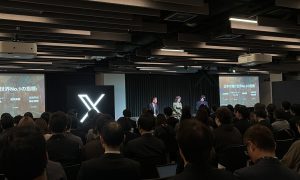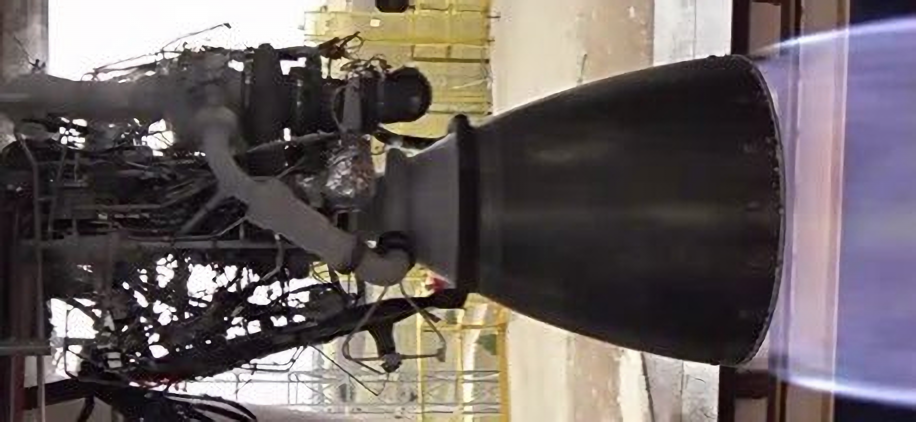

News
SpaceX crushes rocket engine world record during Raptor test
CEO Elon Musk has revealed that SpaceX crushed a global rocketry record during a recent Raptor engine test, pushing the crucial Starship component past years-old performance targets.
On August 17th, the SpaceX CEO unexpectedly released a photo of a Raptor test and a corresponding graph showing the engine’s chamber pressure, confirming that the company had successfully pushed the engine to record-breaking levels. Musk says that an unspecified Raptor – possibly serial number 39 (SN39) – briefly reached a main combustion chamber pressure of 330 bar (~4800 psi) during a controlled burn – and remained intact after shutdown.
Outside of subscale laboratory tests, the highest main combustion chamber known to full-scale, orbital-class rocketry was achieved by the Soviet Union in the 1980s with the RD-701 engine. Although the exceptionally unique engine was canceled before it could be used, it reportedly reached pressures of 290-300 bar in one mode of operation. Now, however, SpaceX and its Raptor engine appear to be the new world record holders – and by a huge margin.
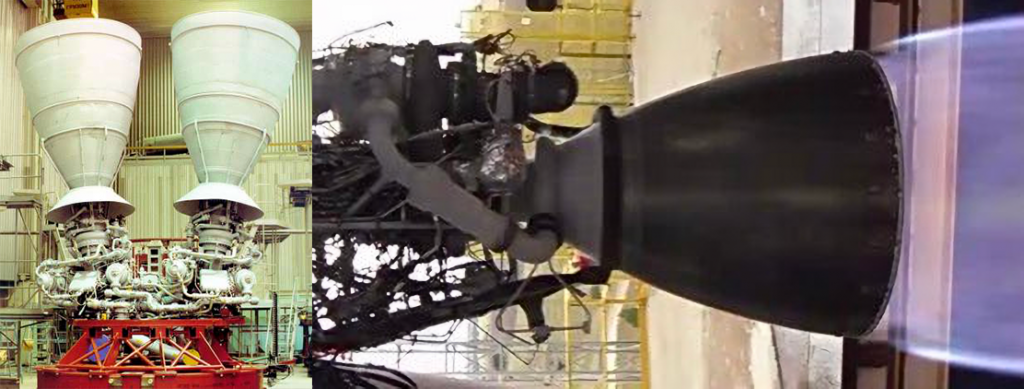
Raptor’s new crown comes roughly 18 months after Elon Musk revealed that the engine had beaten the Soviet RD-270 full-flow staged combustion (FFSC) with a higher sustained chamber pressure (~257 bar vs 255 bar). A few days later, the same Raptor went even further, cresting the Russian RD-180 engine’s 257 bar operating pressure with a peak of 268 bar. Still, SpaceX needed 6-12 more months to refine Raptor into an engine capable of operating even close to those pressures for more than ~10 seconds. In July and August 2019, Raptor engine SN6 flew twice on Starhopper, culminating in a ~60-second, 150-meter hop that ended with the engine nearly destroying itself seconds before landing.
Almost exactly one year later, Raptor SN27 launched on Starship SN5 on the same 150m trajectory and appeared to perform flawlessly. Exhibiting barely a stutter or flare, SN27 never came close to the flamethrower-like death throes Raptor SN6 suffered in August 2019. In short, SpaceX continued to do what SpaceX does best, continuously refining rough prototypes into increasingly polished end products.
Originally revealed in 2016 as a methane/oxygen full-flow staged combustion engine with an operating combustion chamber pressure of 300 bar (4350 psi), Raptor’s August 17th achievement means that SpaceX has already exceeded one of its performance goals. Of course, combustion chamber pressure is significant but still far less important than engine longevity, burn duration limits, and reusability in the context of Starship. SpaceX likely wouldn’t be pushing the envelope of chamber pressure if it wasn’t confident about Raptor’s many other important attributes, but it’s still unknown if Raptor has ever burned for longer than ~90 seconds.
Regardless, if Raptor can actually sustain chamber pressures of 330 bar without damaging itself, the milestone could mean that SpaceX has already boosted Raptor’s maximum thrust from ~200 metric tons to ~225 metric tons (440,000-500,000 lbf. For Starship and Super Heavy, that 10% increase in thrust could easily translate to a 5-10% increase in payload to orbit per launch.
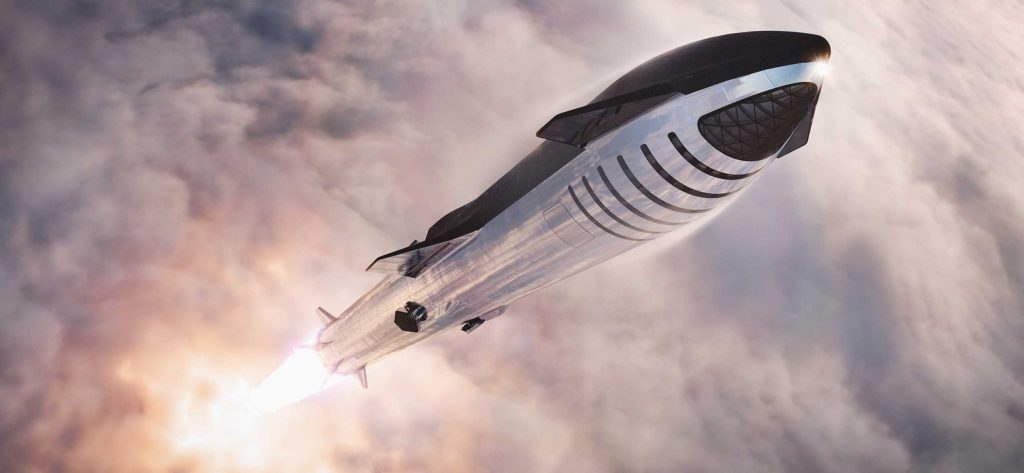
To reach orbit, though, Raptor still has a ways to go. For Super Heavy to be able to complete a normal launch, SpaceX will need to dramatically expand Raptor production (~31 engines per booster) and ensure that Raptor can reliably operate for 3-5+ minutes and reignite multiple times in flight. For Starship, SpaceX needs – at the minimum – to mature Raptor until it can burn continuously for 5-10 minutes to reach orbit. The company will likely also need to finish developing a custom vacuum-optimized version of Raptor for efficient orbital Starship flights.
Given just how quiet SpaceX is about most Raptor milestones, there’s a chance the company has already made substantial progress along those lines. For example, Starship SN8 – already well on its way to completion – will likely be the first prototype to fly with three Raptor engines and will need the ability to stop and start those engines in-flight to perform full-fidelity 20 km (~12.5 mi) launch and landing tests. Even just sustaining 330 bar for 10-100+ seconds without destroying the engine is likely several Raptor iterations away. Still, given SpaceX’s track record, all of those milestones are likely just a matter of time and perseverance.
Check out Teslarati’s Marketplace! We offer Tesla accessories, including for the Tesla Cybertruck and Tesla Model 3.
News
Tesla cleared in Canada EV rebate investigation
Tesla has been cleared in an investigation into the company’s staggering number of EV rebate claims in Canada in January.
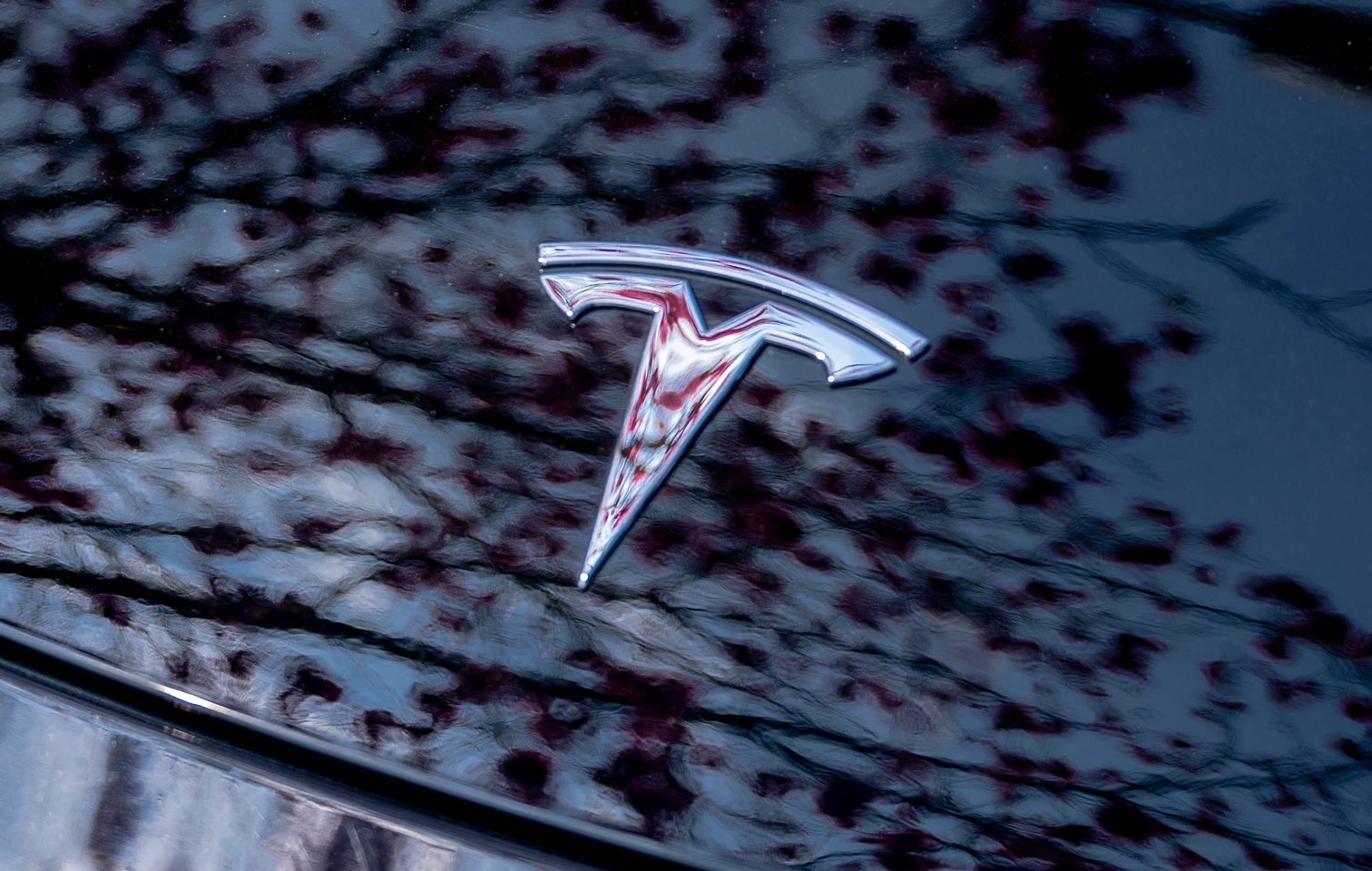
Canadian officials have cleared Tesla following an investigation into a large number of claims submitted to the country’s electric vehicle (EV) rebates earlier this year.
Transport Canada has ruled that there was no evidence of fraud after Tesla submitted 8,653 EV rebate claims for the country’s Incentives for Zero-Emission Vehicles (iZEV) program, as detailed in a report on Friday from The Globe and Mail. Despite the huge number of claims, Canadian authorities have found that the figure represented vehicles that had been delivered prior to the submission deadline for the program.
According to Transport Minister Chrystia Freeland, the claims “were determined to legitimately represent cars sold before January 12,” which was the final day for OEMs to submit these claims before the government suspended the program.
Upon initial reporting of the Tesla claims submitted in January, it was estimated that they were valued at around $43 million. In March, Freeland and Transport Canada opened the investigation into Tesla, noting that they would be freezing the rebate payments until the claims were found to be valid.
READ MORE ON ELECTRIC VEHICLES: EVs getting cleaner more quickly than expected in Europe: study
Huw Williams, Canadian Automobile Dealers Association Public Affairs Director, accepted the results of the investigation, while also questioning how Tesla knew to submit the claims that weekend, just before the program ran out.
“I think there’s a larger question as to how Tesla knew to run those through on that weekend,” Williams said. “It doesn’t appear to me that we have an investigation into any communication between Transport Canada and Tesla, between officials who may have shared information inappropriately.”
Tesla sales have been down in Canada for the first half of this year, amidst turmoil between the country and the Trump administration’s tariffs. Although Elon Musk has since stepped back from his role with the administration, a number of companies and officials in Canada were calling for a boycott of Tesla’s vehicles earlier this year, due in part to his association with Trump.
News
Tesla Semis to get 18 new Megachargers at this PepsiCo plant
PepsiCo is set to add more Tesla Semi Megachargers, this time at a facility in North Carolina.
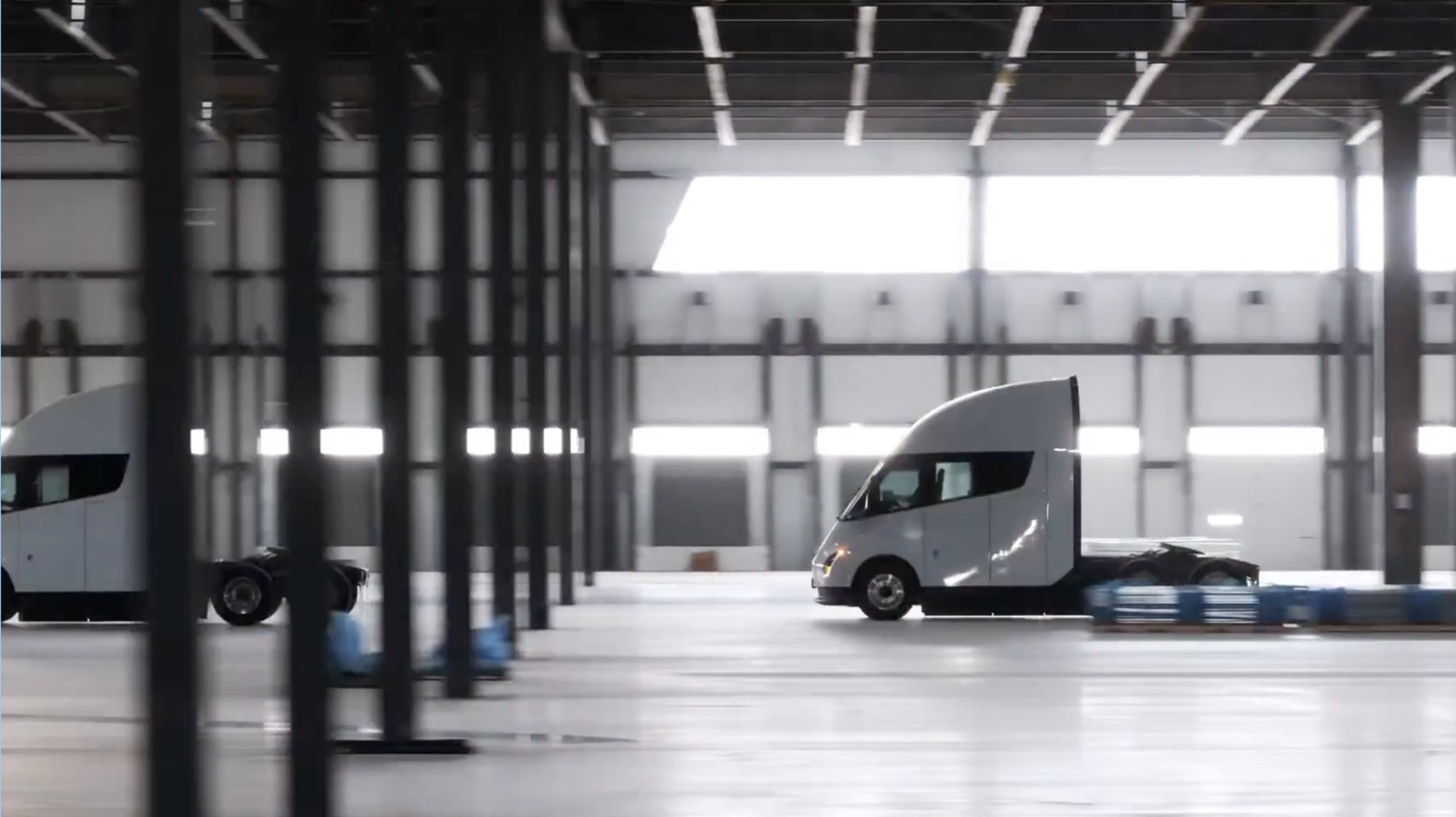
Tesla partner PepsiCo is set to build new Semi charging stations at one of its manufacturing sites, as revealed in new permitting plans shared this week.
On Friday, Tesla charging station scout MarcoRP shared plans on X for 18 Semi Megacharging stalls at PepsiCo’s facility in Charlotte, North Carolina, coming as the latest update plans for the company’s increasingly electrified fleet. The stalls are set to be built side by side, along with three Tesla Megapack grid-scale battery systems.
The plans also note the faster charging speeds for the chargers, which can charge the Class 8 Semi at speeds of up to 1MW. Tesla says that the speed can charge the Semi back to roughly 70 percent in around 30 minutes.
You can see the site plans for the PepsiCo North Carolina Megacharger below.
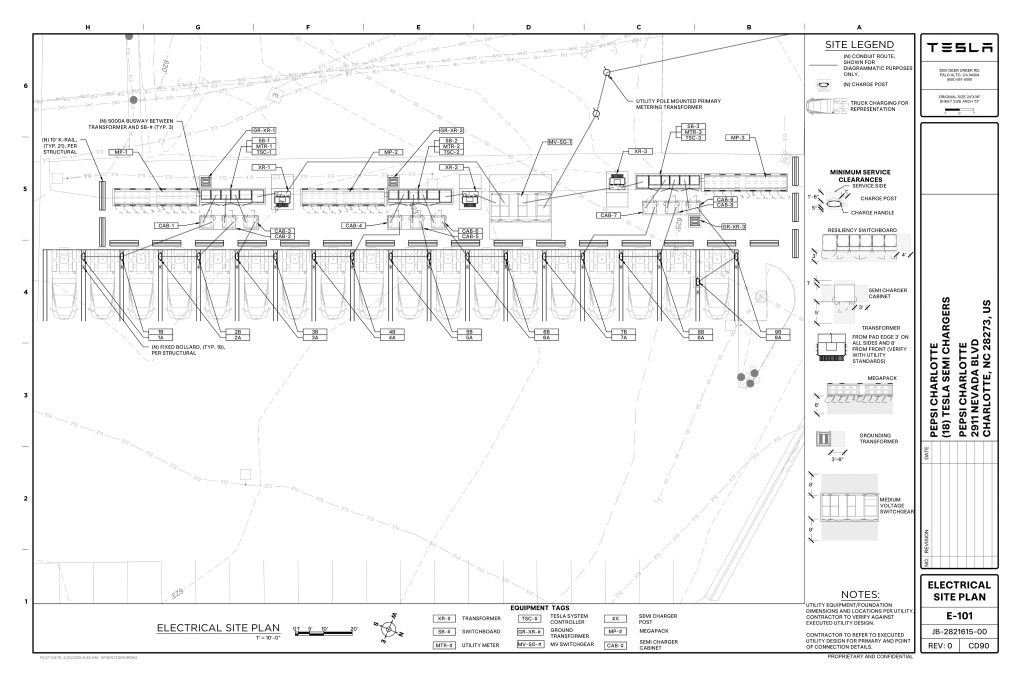
Credit: PepsiCo (via MarcoRPi1 on X)
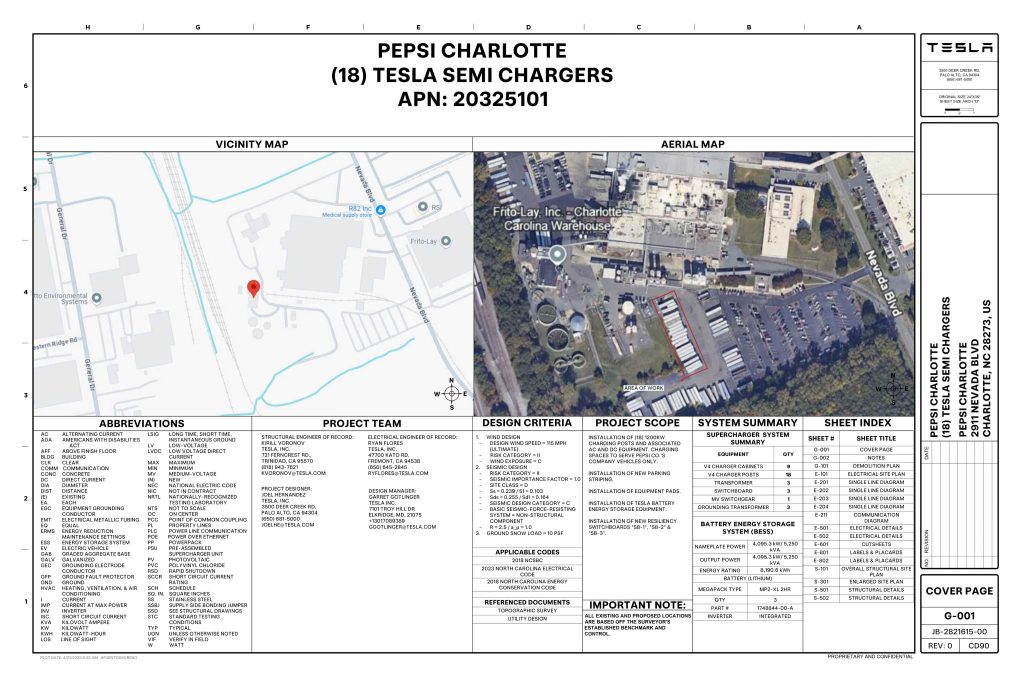
Credit: PepsiCo (via MarcoRPi1 on X)
READ MORE ON THE TESLA SEMI: Tesla to build Semi Megacharger station in Southern California
PepsiCo’s Tesla Semi fleet, other Megachargers, and initial tests and deliveries
PepsiCo was the first external customer to take delivery of Tesla’s Semis back in 2023, starting with just an initial order of 15. Since then, the company has continued to expand the fleet, recently taking delivery of an additional 50 units in California. The PepsiCo fleet was up to around 86 units as of last year, according to statements from Semi Senior Manager Dan Priestley.
Additionally, the company has similar Megachargers at its facilities in Modesto, Sacramento, and Fresno, California, and Tesla also submitted plans for approval to build 12 new Megacharging stalls in Los Angeles County.
Over the past couple of years, Tesla has also been delivering the electric Class 8 units to a number of other companies for pilot programs, and Priestley shared some results from PepsiCo’s initial Semi tests last year. Notably, the executive spoke with a handful of PepsiCo workers who said they really liked the Semi and wouldn’t plan on going back to diesel trucks.
The company is also nearing completion of a higher-volume Semi plant at its Gigafactory in Nevada, which is expected to eventually have an annual production capacity of 50,000 Semi units.
Tesla executive teases plan to further electrify supply chain
News
Tesla sales soar in Norway with new Model Y leading the charge
Tesla recorded a 54% year-over-year jump in new vehicle registrations in June.
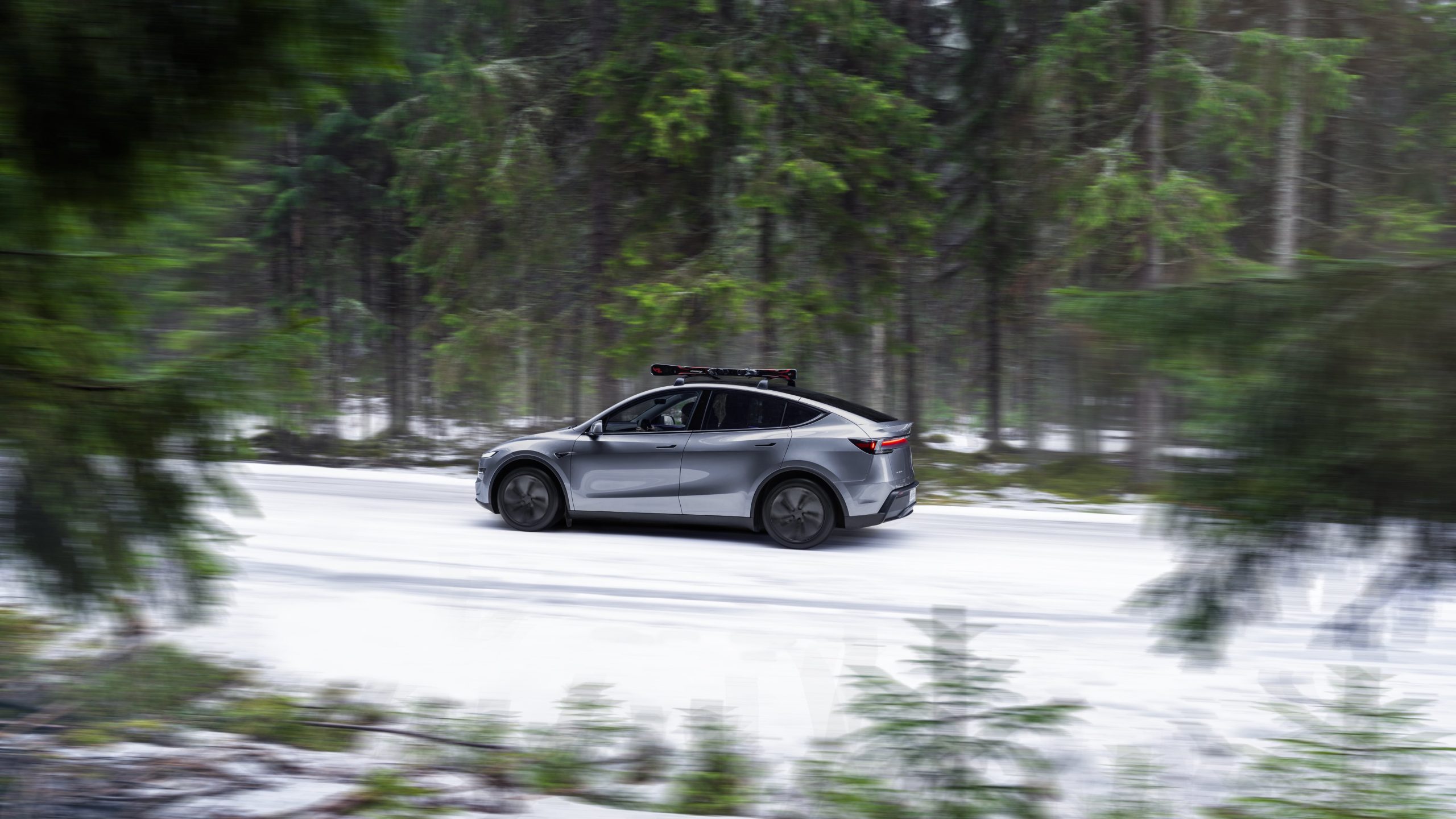
Tesla is seeing strong momentum in Norway, with sales of the new Model Y helping the company maintain dominance in one of the world’s most electric vehicle-friendly markets.
Model Y upgrades and consumer preferences
According to the Norwegian Road Federation (OFV), Tesla recorded a 54% year-over-year jump in new vehicle registrations in June. The Model Y led the charge, posting a 115% increase compared to the same period last year. Tesla Norway’s growth was even more notable in May, with sales surging a whopping 213%, as noted in a CNBC report.
Christina Bu, secretary general of the Norwegian EV Association (NEVA), stated that Tesla’s strong market performance was partly due to the updated Model Y, which is really just a good car, period.
“I think it just has to do with the fact that they deliver a car which has quite a lot of value for money and is what Norwegians need. What Norwegians need, a large luggage space, all wheel drive, and a tow hitch, high ground clearance as well. In addition, quite good digital solutions which people have gotten used to, and also a charging network,” she said.
Tesla in Europe
Tesla’s success in Norway is supported by long-standing government incentives for EV adoption, including exemptions from VAT, road toll discounts, and access to bus lanes. Public and home charging infrastructure is also widely available, making the EV ownership experience in the country very convenient.
Tesla’s performance in Europe is still a mixed bag, with markets like Germany and France still seeing declines in recent months. In areas such as Norway, Spain, and Portugal, however, Tesla’s new car registrations are rising. Spain’s sales rose 61% and Portugal’s sales rose 7% last month. This suggests that regional demand may be stabilizing or rebounding in pockets of Europe.
-

 Elon Musk2 weeks ago
Elon Musk2 weeks agoTesla investors will be shocked by Jim Cramer’s latest assessment
-

 Elon Musk2 days ago
Elon Musk2 days agoxAI launches Grok 4 with new $300/month SuperGrok Heavy subscription
-

 Elon Musk4 days ago
Elon Musk4 days agoElon Musk confirms Grok 4 launch on July 9 with livestream event
-

 News1 week ago
News1 week agoTesla Model 3 ranks as the safest new car in Europe for 2025, per Euro NCAP tests
-

 Elon Musk2 weeks ago
Elon Musk2 weeks agoA Tesla just delivered itself to a customer autonomously, Elon Musk confirms
-

 Elon Musk1 week ago
Elon Musk1 week agoxAI’s Memphis data center receives air permit despite community criticism
-

 News2 weeks ago
News2 weeks agoXiaomi CEO congratulates Tesla on first FSD delivery: “We have to continue learning!”
-

 News2 weeks ago
News2 weeks agoTesla sees explosive sales growth in UK, Spain, and Netherlands in June


